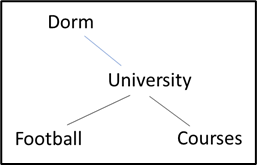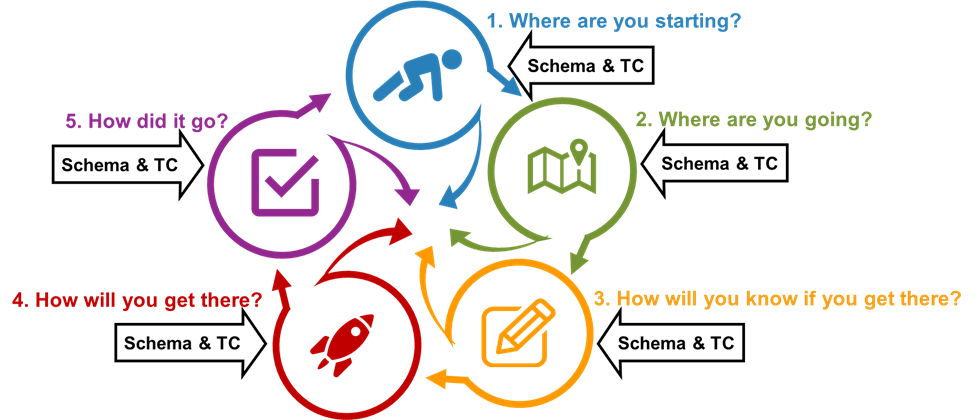
Unit A – Teaching & Learning Theories
A2. Schemas & Threshold Concepts
Schemas & Threshold Concepts
Schema Defined
(The plural of ‘schema’ can be either ‘schemas’ or ‘schemata’)
Transformative learning requires a change in schemas. Schemas can transform by adding to, replacing, refining, and/or deleting old knowledge. Creative and critical problem-solving can use current SKAs and provide new answers, however, new knowledge can also build new connections between schemas.
Prior knowledge is organized in schemas. A schema is a mental link between experiences, memories, people, places, objects, generalizations, etc. (Vinney, 2019). An existing schema is the relationships the student uses to connect concepts such as topics and actions (Pritchard, 2017, p. 22). Schemas help people quickly identify and categorize information. Schemas act as shortcuts, shortening the processing time between stimulus and response.
Schemas are long-lasting (Vinney, 2019). Some schema links are very strong while others may be tentative. For example, many people have a strong link between ‘librarian’ and ‘book.’ Furthermore, when people experience something, they tend to focus on aspects that are consistent with their current schema. For example, Cohen (1981) found that stereotypic knowledge was used by people when recalling features and behaviors of actors.
When people are faced with information that conflicts with their schema, they may have difficulty accepting the new information.
Schema can be used in teaching to provide students with comparisons and examples. However, as schema are different for each person, you need to understand the student background to determine if a particular comparison will work. For example, comparing a cloud-based drive system using a file cabinet analogy will work with many older students, but perhaps not younger ones.
Examples
A very simple schema may look like Figure 1. A student may mentally link ‘university’ to ‘courses’, ‘dorms’, and ‘football’. For most people, each of these would also link to many other thoughts, including emotions.
Figure: Simple Schema

Schemas might have many connections. For example, while one person might have a simple schema for ‘university’, another may have significantly more complex schema, with connections to ‘clubs’, ‘homework’, ‘high school’, ‘tests’, ‘friends’, etc. In turn, a ‘friends’ schema might include ‘movies’, ‘food’, ‘games’, ‘fun’, ‘acquaintances’, ‘clubs’…. A schema may also have emotional links such as ‘daunting’, ‘exciting’, ‘difficult’, ‘boring’, ‘confusing’, etc.
Threshold Concepts (TCs)
According to Davis (2014, p.25):
In the interpretation of messages, comprehension develops as the mind interacts with the characteristics of the message, using clues from it to fit the new data into a place in the existing knowledge structure. The process is heavily influenced by the individual’s existing knowledge and his analysis of the context.
Threshold concept (TC) theory focuses on the introduction of knowledge that requires a transformational shift in schema, such as a change in knowledge, approach, or belief. Often, a threshold concept holds students from moving beyond their current schema. It changes their view of the discipline. In some cases, the learning outcome may also transform the students’ world view.
(For more about the difference and relationship between schemas and threshold concepts, see Walker, 2013.)
A threshold concept can be considered as akin to a portal, opening up a new and previously inaccessible way of thinking about something. It represents a transformed way of understanding, or interpreting, or viewing something without which the learner cannot progress [emphasis added]. As a consequence of comprehending a threshold concept there may thus be a transformed internal view of subject matter, subject landscape, or even world view. This transformation may be sudden or it may be protracted over a considerable period of time, with the transition to understanding proving troublesome. Such a transformed view or landscape may represent how people ‘think’ in a particular discipline, or how they perceive, apprehend, or experience particular phenomena within that discipline (or more generally). (Meyer and Land, 2006, pg. 1).
Threshold concepts are the blocks “where students ‘get stuck’. TCs, then, are transformative. When mastered, TCs are what enable students to look at problems in completely new ways” (Walker, 2013, p.247). “Here, we imply transformation not only at the cognitive level, but also at the epistemological and ontological levels – that is, transformation in ways of thinking, practising, and ‘being’” (Timmermans & Meyer, 2019, p. 356).
TCs can cause cognitive dissonance by challenging current beliefs or ways of thinking about a topic. “Threshold concepts require a change of thinking. They’re conceptually difficult, counterintuitive or, in Meyer and Land’s terms, troublesome” (Kim, 2019). This cognitive dissonance may result in some students vacillating between accepting and not accepting the new view(s).
Research indicates that people may feel considerable internal conflict and tend to resist the implications of new information if acceptance would require a major cognitive reorganization (Anderson et al., 1977, pp. 424–425). “This point has special application for cross-cultural educators and explains—from a psychological viewpoint—why new messages may be strenuously rejected” (Davis, 2014, p. 26).
When a student has internalised a threshold concept they are more able to integrate different aspects of a subject in their analysis of problems. On acquiring a threshold concept a student is able to transform their use of the ideas of a subject because they are now able to integrate them in their thinking (Land, 2006, p. 195).
Timmermans & Meyer (2019, p.364) provide an approach for how to identify and teach TCs. Some of these have been included in the IDI & Schema & TC section below. For details on the steps in their approach, refer to the Timmermans & Meyer, 2019 article.
Accepting Conflicting Information
Students enter a course with a set of schemas. To accept and retain new knowledge, the student must change one or more schemas. “New learning concerned with the particular topic will involve the processes of accommodation and assimilation, and the expansion and increase in complexity of the schema in question” (Pritchard, 2017, p. 21).
According to Ormrod et al., (2019, p.224-225), students resist change for several reasons:
- “Students’ existing beliefs affect their interpretations of new information.”
- “People of all ages (even college students!) tend to actively look for information that confirms their existing beliefs and to ignore or discredit contradictory evidence—a phenomenon called confirmation bias.”
- “Students existing beliefs may be more consistent with their everyday experiences.”
- “Some beliefs are integrated into a cohesive whole, with many interconnections between ideas…. Changing misconceptions involves changing a tightly organized set of understandings… rather than a single belief.”
- “Students may fail to notice an inconsistency between new information and their existing beliefs.”
- “Students may have a personal or emotional investment in their existing beliefs.”
Instructors may, therefore, need to consider Bloom’s affective taxonomy when selecting strategies.
IDI & Schemas & Threshold Concepts

The following describe actions you can take to use concepts from schema and TC in the IDI model:
Step 1. Where are You Starting?
1.1 Review Course Requirements
- Identify what courses and SKAs students have been exposed to before your course.
- Identify threshold concepts (See Flanagan, 2020 for discipline-specific articles).
Suggestion: ask your program committee to identify threshold concepts and define which courses should include each.
1.2 Identify Student Learning Characteristics
- Review student learning characteristics such as age and culture to identify potential TCs and typical schemas. Based on your experience and other instructors’ experience, what are the typical schema that students bring that you might need to address? Remember these are generalizations only.
Step 2. Where are You Going?
2.1 Write Learning Outcomes & Objectives
- Based on pre-requisite courses and student learning characteristics, identify methods for attaching new learning to current schemas
- Write learning outcomes and objectives for each identified potential TC.
2.2 Finalize Learning Model
- Based on student learning characteristics, identify methods, such as examples and activities, for attaching new learning to current schemas.
- Start with the known and help students add new knowledge, skills, or attitudes. This supports moving the new learning from working memory to long-term memory.
Step 3. How Will You Know If You Get There?
3.1 Develop Assessments & Rubrics
- Consider a pre-course or unit assessment to determine student current understanding. Based on this, review your outcomes and objectives.
- Create assessments which require students to analyze the new information. Include a reflective assignment.
- Determine how you will measure student movement through troublesome concepts.
- Determine consequences for students unable to move through a TC.
- Create rubrics and write metaphors and examples
Step 4. How Will You Get There?
4.1 Develop & Teach Course
- Ask students to analyze and contrast conflicting information (Ormrod et al., 2019, p.208).
- Bring in a respected guest speaker who may challenge student current schema.
- Have students test various hypotheses to help them identify (Ormrod et al., 2019, p.208).
- Draw upon many media—music, role play, games, visual aids, audio presentations, pencil and paper practice, etc. (Davis, 2014).
- Provide data and information that show how current schema is inappropriate or incorrect (Ormrod et al., 2019, p. 226).
- Ask students to develop pros and cons, potentially in small groups.
- Often, Land (2006, p. 195) explains, students need to know how the information was determined and/or why it is believed.
- Start with the known and help students add new knowledge, skills, or attitudes. This supports moving the new learning from working memory to long-term memory.
- Tell students about the threshold concept they are struggling with, define it (Timmermans & Meyer, 2019).
- Use students’ schemas to build new knowledge (Ormrod et al., 2019, p.209).
- When students are having trouble with a concept, provide a series of examples and non-examples and ask students to explain. (Ormrod et al., 2019, p.237).
- Show how one explanation of an event or phenomenon makes more sense than others” (Ormrod et al., 2019, p.209).
- Ask students to explain new data and information (Ormrod et al., 2019, p. 226).
- Use metaphors to help explain new information (Timmermans & Meyer, 2019, p. 363).
- Monitor what students are saying and writing for signs of persistent misconceptions (Ormrod et al., 2019, p.237).
Step 5. How Did It Go?
5.1 Evaluate Course Success
- At the end of each session, take notes on the class outline on how the students managed with new content.
References
Anderson, R. C., Spiro, R. J., R, J., & Anderson, M. C. (1977). Schemata as scaffolding for the representation of information in connected discourse / (No. 24; p. 24). University of Illinois at Urbana-Champaign. https://www.ideals.illinois.edu/items/17664.
Cohen, C. E. (1981). Person categories and social perception: Testing some boundaries of the processing effect of prior knowledge. Journal of Personality and Social Psychology, 40(3), 441–452. Scopus. https://doi.org/10.1037/0022-3514.40.3.441.
Davis, P. M. (2014). Cognition and learning: A review of the literature with reference to ethnolinguistic minorities. Summer Institute of Linguistics.
Kim, J. (2019, March 20). Wrestling with the “threshold concepts” in learning innovation (opinion) | Inside Higher Ed. https://www.insidehighered.com/digital-learning/blogs/technology-and-learning/wrestling-threshold-concepts-learning-innovation.
Land, R. (2006). Conclusion: Implications of threshold concepts for course design and evaluation. In Overcoming barriers to student understanding: Threshold concepts and troublesome knowledge. Routledge.
Meyer, J., & Land, R. (Eds.). (2006). Overcoming barriers to student understanding: Threshold concepts and troublesome knowledge. Routledge.
Ormrod, J. E., Anderman, E. M., & Anderman, L. H. (2019). Educational Psychology: Developing learners (10e ed.). PRENTICE HALL.
Pritchard, A. (2017). Ways of Learning: Learning Theories for the Classroom. Routledge.
Threshold concept—EduTech Wiki. (n.d.). Retrieved June 24, 2020, from http://edutechwiki.unige.ch/en/Threshold_concept.
Timmermans, J. A., & Meyer, J. H. F. (2019). A framework for working with university teachers to create and embed ‘Integrated Threshold Concept Knowledge’ (ITCK) in their practice. International Journal for Academic Development, 24(4), 354–368. https://doi.org/10.1080/1360144X.2017.1388241.
Vinney, C. (2019, July 22). What Is a Schema in Psychology? Definition and Examples. ThoughtCo. https://www.thoughtco.com/schema-definition-4691768.
Walker, G. (2013). A cognitive approach to threshold concepts. Higher Education Volume, 65, 247–263.
